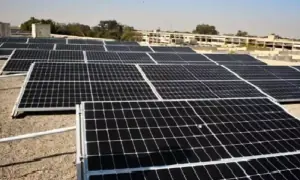World Bank projects Pakistan's GDP growth rate at 4%
The World Bank has projected Pakistan’s GDP growth rate at 4 per cent for 2022-23, benefiting from structural reforms enhancing export competitiveness and improving the financial viability of the power sector.
The World Bank in its latest report “Global Economic Prospects report,” stated that high inflation in Pakistan led to the removal of monetary accommodation. Monetary policy is expected to tighten but continue to be moderately accommodative in 2022 (except Pakistan), to support growth while protecting against an increase in medium-term inflation expectations.
The per capita incomes are projected to fall further behind advanced economies in 2021 -23 in Pakistan, the largest relative decline at almost 2 percentage points per year.
In Pakistan, output is expected to grow by 3.4 percent in fiscal year 2021-22, ending June 2022, and by 4.0 percent the next fiscal year.
Growth in Pakistan surprised on the upside last year supported by improving domestic demand, record-high remittance inflows, a narrow targeting of lockdowns, and accommodative monetary policy—real interest rates dropped precipitously during 2020 and remained negative throughout most of 2021, it added.
The report noted that in Bangladesh, strong export growth, supported by returning readymade garment demand from abroad, and a rebound in domestic demand—with improving labour income and remittance inflows—supported the recovery. Both Bangladesh and Pakistan saw their goods trade deficit widen to record levels on strong domestic demand and rising energy prices.
Macroeconomic policy remained broadly accommodative last year. Monetary policy became more accommodative as real interest rates went further negative on rising inflation expectations, but still low policy rates, the trend only reversing in Pakistan following a rapid policy rate increase. Fiscal policy remained broadly accommodative as real government expenditure expanded at a faster pace in 2021 than in 2020.
In Pakistan, facing fiscal pressures, however, real government expenditure contracted in 2021. Low government bond yields and rebounding growth assisted in stabilizing gross government debt levels in the region, on average, during last year but at elevated levels.
Growth in SAR is projected to accelerate to 7.6 percent in 2022, as pandemic-related disruptions fade, before slowing to 6.0 percent in 2023. Growth projections have been revised up since June 2021 for each year of the forecast period, largely reflecting better prospects in Bangladesh, India and Pakistan.
Domestic financial conditions in major SAR economies have been mixed. In Pakistan and Sri Lanka, long-term bond yields have rebounded rapidly in late 2021 reversing the lows reached during the pandemic. In India, by contrast, 10- year government bond yields had only partly reversed the declines that occurred in the first half of 2020, with evidence of only limited increases in term premia, inflation expectations, and real short rates.
Equity market valuations in the region have increased in line with global markets and as of early 2022 were about 50 percent above their levels in January 2020, on average. Macroeconomic policy remained broadly accommodative last year.
Monetary policy became more accommodative as real interest rates went further negative on rising inflation expectations, but still low policy rates, the trend only reversing in Pakistan following a rapid policy rate increase.
Fiscal policy remained broadly accommodative as real government expenditure expanded at a faster pace in 2021 than in 2020. In Pakistan, facing fiscal pressures, however, real government expenditure contracted in 2021. Low government bond yields and rebounding growth assisted in stabilizing gross government debt levels in the region, on average, during last year but at elevated levels.
In the sub-region excluding India, growth is projected at 4.4 percent in fiscal year 2021-22, 1.3 percentage points higher than in the June 2021 forecast, and 4.8 percent in fiscal year 2022-23.
Output losses compared to pre-pandemic trends remain significant in the region. Fiscal policy will support growth, but unwind, over the forecast horizon.
Although SAR is projected to continue making progress in catching up with advanced-economy per capita incomes, the pace of catch-up will be slower in the forecast period than in the decade prior to the pandemic, in part reflecting more limited policy support than in advanced economies, scarring from the pandemic, and fiscal challenges in Pakistan and Sri Lanka. In fact, per capita incomes are projected to fall further behind advanced economies in 2021 -23 in Bhutan, Nepal, Pakistan (facing the largest relative decline at almost 2 percentage points per year), and Sri Lanka.
Despite rebounding growth and an upgraded forecast, the number of people living on less than $1.90 per day is expected to remain above pre-pandemic levels, with tens of millions of new poor in SAR since 2020. Growing poverty rates combined with increases in employment informality, deteriorating labour markets, and rising food insecurity have contributed to inequality.
The story was published in Business Recorder on January 12, 2022.
For the latest news, follow us on Twitter @Aaj_Urdu. We are also on Facebook, Instagram and YouTube.
















Comments are closed on this story.